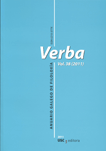La morfologización de las armonizaciones vocálicas en el centro de Asturias: innovación y escisión protorromance
Contido principal do artigo
Resumo
La metafonía románica tiene una importante dimensión morfológica por cuanto sus resultados fonéticos repercuten en la marcación de valores distintivos tanto en el verbo como en nombres y adjetivos. Es el caso de su variedad asturiana, donde la inflexión ante morfema flexivo –u contribuye a la caracterización del masculino singular (pirru) frente a femeninos y plurales (perra, perros) y adjetivos neutros (nigru, pero negra o negro). Este trabajo propone un enfoque actualizado y comprensivo de estos fenómenos poniendo el foco en los procesos de morfologización de la inflexión vocálica de la región centro-meridional de Asturias. Siendo este un espacio de transición entre los dos grandes bloques dialectales del asturiano, un análisis detenido de sus peculiaridades puede ayudar a profundizar en las claves últimas de la diferenciación interna de este dominio y, por extensión, de todo el occidente peninsular.
Palabras chave
Detalles do artigo
Citas
Alonso, Dámaso (1972): “Metafonía, neutro de materia y colonización suditaliana en la Península hispánica”, en Obras completas. Vol. I (Estudios lingüísticos peninsulares). Madrid: Gredos, t. I, pp.147-214.
Arias Cabal, Álvaro (1992): “Metafonía en Felechosa (Ayer): caltenimientu de la inflesión ensin /-u/ final”, Lletres Asturianes 46, pp.7-21.
Barker, Chris (1999): “Individuation and Quantification”, Linguistic Inquiry 30/4, pp.683-691. https://doi.org/10.1162/002438999554264
Blasco Ferrer, Eduardo (2016): Corso di linguistica sarda e romanza. Firenze: Franco Cesati Editore.
Corbett, Greville G. (2000): Number. Cambridge: Cambridge University Press.
https://doi.org/10.1017/CBO9781139164344
García Arias, Xosé Lluis (2003): Gramática histórica de la lengua asturiana. Uviéu: Academia de la Llingua Asturiana.
García Arias, Xosé Lluis (2003): “Aspeutos evolutivos del vocalismu nel dominiu ástur”, Lletres asturianes82, pp. 15-40.
Greenberg, J. H. (1972): "Numeral Classifiers and Substantival Number: problems in the Genesis of a Linguistic Type", Working Papers on Language Universals 9, pp. 2-39.
Herburger, Elena (2016): What Counts. Focus and Quantification. Cambridge, Massachussets: MIT Press.
Hopper P. J. y E.C. Traugott (2004): Gramaticalization. Cambridge: Cambridge University Press.
Hualde, José Ignacio (1989): “Autosegmental and Metrical Spreading in the Vowel-Harmony Systems of Northwestern Spain”, Linguistics 27/5, pp. 773-805. https://doi.org/10.1515/ling.1989.27.5.773
McCarthy, John (1984): “Theoretical Consequences of Montañés Vowel Harmony”, Linguistic Inquiry 15, pp. 291-318.
Menéndez García, Manuel (2014): Palabras y cosas de Bermiego (Quirós) (1950-1961). Oviedo: Universidad de Oviedo.
Neira Martínez, Jesús (1955): El habla de Lena. Oviedo: Instituto de Estudios Asturianos. (reimp. 2005)
Penny, Ralph J. (1969): “Vowel-Harmony in the Speech of the Montes de Pas (Santander)”, Orbis 18, pp. 148-166.
Penny, Ralph J. (1994): “Continuity and Innovation in Romance: Metaphony and Mass-Noun Reference in Spain and Italy”, Modern Language Review 89, pp. 273-281.
https://doi.org/10.2307/3735232
Penny, Ralph J. (2009): “Vowel Harmony and Metaphony in Iberia: A Revised Analysis”, Estudos de Lingüística Galega 1, pp. 113-124.
Picard, Marc (2001): “Vowel Harmony, Centralization, and Peripherality: The Case of Pasiego”, Linguistics 39, pp. 117-32.
https://doi.org/10.1515/ling.2001.001
Rodríguez Castellano, Lorenzo (1955): “Más datos sobre la inflexión vocalica en la zona centro-sur de Asturias”, Boletín del Instituto de Estudios Asturianos 24, pp.123-146.
Rodríguez Castellano, Lorenzo (1952): La variedad dialectal del Alto Aller. Oviedo: Instituto de Estudios Asturianos. (Reeimp. 1986).
San Segundo Cachero, Rosabel (2015): “El neutro de materia en la morfología nominal del asturiano del concejo de L.lena”, Lletres Asturianes 112, pp.11-37.
Spencer, Andrew (1986): “Vowel Harmony, Neutral Vowels and Autosegmental Theory”, Lingua 69, pp.3-21.
https://doi.org/10.1016/0024-3841(86)90021-5, https://doi.org/10.1016/0024-3841(86)90076-8
Vago, Robert (1988): “Underspecification Theory in the Dual Harmony System of Pasiego (Spanish)”, Phonology 5/2, pp. 343-362. https://doi.org/10.1017/S0952675700002347
Viejo Fernández, Xulio (2001): “Metafonía y contrametafonía en quirosán: pragmática, determín léxicu y morfosintaxis”, Revista de Filoloxía Asturiana 1, pp. 71-114.
Viejo Fernández, Xulio (2004): “Metafonía y diptongación en protorromance hispánico: la variable pragmática y sociolingüística a la luz de nuevos datos asturianos”, Verba 31, pp. 281-303.
Viejo Fernández, Xulio (2004): “Patrones de vocalismu palatal final na fala de Quirós: implicaciones pragmátiques y gramaticales”, Lletres Asturianes 85, pp. 7-28.
Viejo Fernández, Xulio (2013): “Geminación consonántica y variación vocálica en asturiano. Nuevos datos para el estudio de la evolución fonológica románica”, Estudis Romànics 35, pp. 7-25. https://doi.org/10.2436/20.2500.01.116.
Wilson, Tom (1988): “Blocking and Repair in Pasiego Vowel Harmony”, Toronto Working Papers in Linguistics 9 (1988), pp. 141-171.
Artigos máis lidos do mesmo autor/a(s)
- Xulio Viejo Fernández, Córdoba Rodríguez, Félix / Ernesto González Seoane / María Dolores Sánchez Palomino (2014): Lexicografía de las lenguas románicas. Perspectiva histórica. Volumen I. Berlin / Boston: De Gruyter, 332 pp. , Estudos de Lingüística Galega: Vol 9 (2017)






